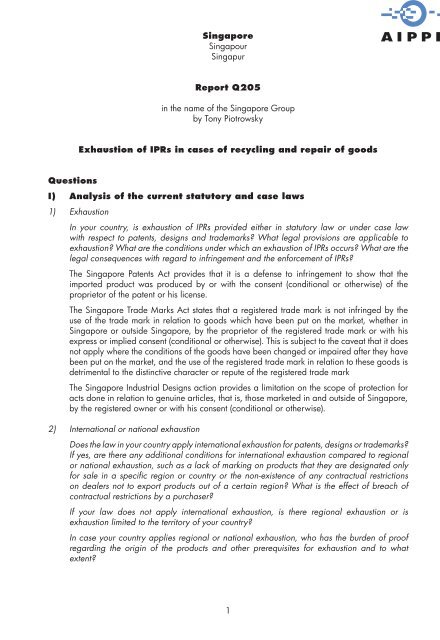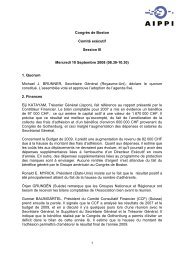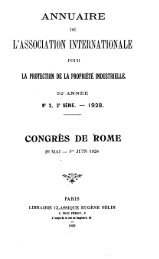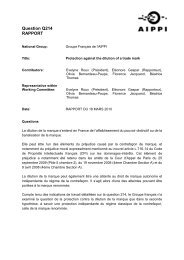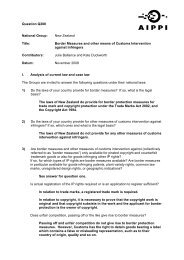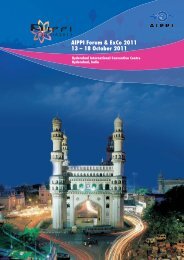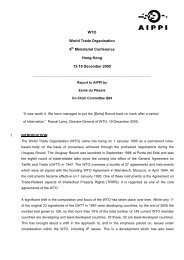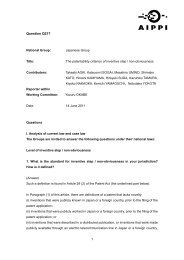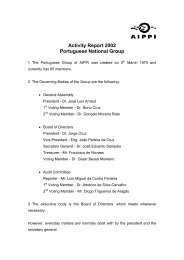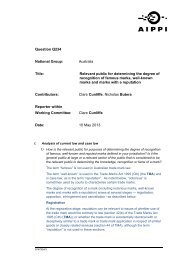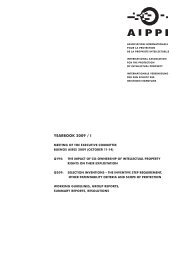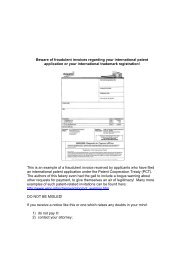1 Singapore Singapour Singapur Report Q205 in the name ... - AIPPI
1 Singapore Singapour Singapur Report Q205 in the name ... - AIPPI
1 Singapore Singapour Singapur Report Q205 in the name ... - AIPPI
Create successful ePaper yourself
Turn your PDF publications into a flip-book with our unique Google optimized e-Paper software.
<strong>S<strong>in</strong>gapore</strong><br />
<strong>S<strong>in</strong>gapour</strong><br />
<strong>S<strong>in</strong>gapur</strong><br />
<strong>Report</strong> <strong>Q205</strong><br />
<strong>in</strong> <strong>the</strong> <strong>name</strong> of <strong>the</strong> <strong>S<strong>in</strong>gapore</strong> Group<br />
by Tony Piotrowsky<br />
Exhaustion of IPRs <strong>in</strong> cases of recycl<strong>in</strong>g and repair of goods<br />
Questions<br />
I) Analysis of <strong>the</strong> current statutory and case laws<br />
1) Exhaustion<br />
In your country, is exhaustion of IPRs provided ei<strong>the</strong>r <strong>in</strong> statutory law or under case law<br />
with respect to patents, designs and trademarks? What legal provisions are applicable to<br />
exhaustion? What are <strong>the</strong> conditions under which an exhaustion of IPRs occurs? What are <strong>the</strong><br />
legal consequences with regard to <strong>in</strong>fr<strong>in</strong>gement and <strong>the</strong> enforcement of IPRs?<br />
The <strong>S<strong>in</strong>gapore</strong> Patents Act provides that it is a defense to <strong>in</strong>fr<strong>in</strong>gement to show that <strong>the</strong><br />
imported product was produced by or with <strong>the</strong> consent (conditional or o<strong>the</strong>rwise) of <strong>the</strong><br />
proprietor of <strong>the</strong> patent or his license.<br />
The <strong>S<strong>in</strong>gapore</strong> Trade Marks Act states that a registered trade mark is not <strong>in</strong>fr<strong>in</strong>ged by <strong>the</strong><br />
use of <strong>the</strong> trade mark <strong>in</strong> relation to goods which have been put on <strong>the</strong> market, whe<strong>the</strong>r <strong>in</strong><br />
<strong>S<strong>in</strong>gapore</strong> or outside <strong>S<strong>in</strong>gapore</strong>, by <strong>the</strong> proprietor of <strong>the</strong> registered trade mark or with his<br />
express or implied consent (conditional or o<strong>the</strong>rwise). This is subject to <strong>the</strong> caveat that it does<br />
not apply where <strong>the</strong> conditions of <strong>the</strong> goods have been changed or impaired after <strong>the</strong>y have<br />
been put on <strong>the</strong> market, and <strong>the</strong> use of <strong>the</strong> registered trade mark <strong>in</strong> relation to <strong>the</strong>se goods is<br />
detrimental to <strong>the</strong> dist<strong>in</strong>ctive character or repute of <strong>the</strong> registered trade mark<br />
The <strong>S<strong>in</strong>gapore</strong> Industrial Designs action provides a limitation on <strong>the</strong> scope of protection for<br />
acts done <strong>in</strong> relation to genu<strong>in</strong>e articles, that is, those marketed <strong>in</strong> and outside of <strong>S<strong>in</strong>gapore</strong>,<br />
by <strong>the</strong> registered owner or with his consent (conditional or o<strong>the</strong>rwise).<br />
2) International or national exhaustion<br />
Does <strong>the</strong> law <strong>in</strong> your country apply <strong>in</strong>ternational exhaustion for patents, designs or trademarks?<br />
If yes, are <strong>the</strong>re any additional conditions for <strong>in</strong>ternational exhaustion compared to regional<br />
or national exhaustion, such as a lack of mark<strong>in</strong>g on products that <strong>the</strong>y are designated only<br />
for sale <strong>in</strong> a specific region or country or <strong>the</strong> non-existence of any contractual restrictions<br />
on dealers not to export products out of a certa<strong>in</strong> region? What is <strong>the</strong> effect of breach of<br />
contractual restrictions by a purchaser?<br />
If your law does not apply <strong>in</strong>ternational exhaustion, is <strong>the</strong>re regional exhaustion or is<br />
exhaustion limited to <strong>the</strong> territory of your country?<br />
In case your country applies regional or national exhaustion, who has <strong>the</strong> burden of proof<br />
regard<strong>in</strong>g <strong>the</strong> orig<strong>in</strong> of <strong>the</strong> products and o<strong>the</strong>r prerequisites for exhaustion and to what<br />
extent?<br />
1
<strong>S<strong>in</strong>gapore</strong> applies <strong>in</strong>ternational exhaustion for patents, designs and trademarks. It is noted,<br />
however, that <strong>the</strong> U.S./<strong>S<strong>in</strong>gapore</strong> FTA conta<strong>in</strong>s requires that <strong>S<strong>in</strong>gapore</strong> recognize a right of<br />
a patent holder to restrict importation through contracts. See also comments to question 1<br />
above.<br />
3) Implied license<br />
Does <strong>the</strong> <strong>the</strong>ory of implied license have any place <strong>in</strong> <strong>the</strong> laws of your country? If so, what<br />
differences should be noted between <strong>the</strong> two concepts of exhaustion and implied license?<br />
In <strong>S<strong>in</strong>gapore</strong>, <strong>in</strong>tellectual property licenses can arise by necessary implication from <strong>the</strong><br />
circumstances surround<strong>in</strong>g a transaction. Licenses are implied to lend efficacy to a bus<strong>in</strong>ess<br />
arrangement. However, <strong>the</strong> <strong>S<strong>in</strong>gapore</strong> courts are less likely to imply a license for <strong>the</strong> purpose<br />
of exclud<strong>in</strong>g <strong>in</strong>fr<strong>in</strong>gement altoge<strong>the</strong>r, even if that follows as a necessary consequence of<br />
<strong>the</strong> implication. Firm judicial caution aga<strong>in</strong>st <strong>the</strong> exorbitant use of implied licenses to excuse<br />
<strong>in</strong>fr<strong>in</strong>g<strong>in</strong>g acts was issued by <strong>the</strong> <strong>S<strong>in</strong>gapore</strong> Court of Appeal.<br />
4) Repair of products protected by patents or designs<br />
Under what conditions is a repair of patented or design-protected products permitted under<br />
your national law? What factors should be considered and weighed? Does your law provide<br />
for a specific def<strong>in</strong>ition of <strong>the</strong> term “repair” <strong>in</strong> this context?<br />
While <strong>S<strong>in</strong>gapore</strong> recognizes <strong>the</strong> non-derogation of grant doctr<strong>in</strong>e (or ‘repair exception’) under<br />
which a person may repair an article as part of <strong>the</strong> orig<strong>in</strong>al grant of <strong>the</strong> orig<strong>in</strong>al design, it<br />
is has been careful applied. For example, cases have demonstrated a judicial reluctance to<br />
extend <strong>the</strong> ‘repair exception’ to o<strong>the</strong>r situations. In one case, <strong>the</strong> defendants (who made use<br />
of <strong>the</strong> pla<strong>in</strong>tiffs’ source code for <strong>the</strong> limited purpose of repaid and ma<strong>in</strong>tenance) were not<br />
entitled to copy <strong>the</strong> source programs <strong>in</strong> <strong>the</strong> absence of a license. In ano<strong>the</strong>r case, a defendant<br />
argued that it had an implied right to make an <strong>in</strong>termediate copy of a software program,<br />
<strong>in</strong> <strong>the</strong> course of reverse eng<strong>in</strong>eer<strong>in</strong>g activity, based on <strong>the</strong> ‘repair exception.’ The Court of<br />
Appeal dismissed this argument, on <strong>the</strong> primary ground that <strong>the</strong> ‘creation of a compatible<br />
and compet<strong>in</strong>g product is materially dist<strong>in</strong>guishable from a situation of repair.’ In more recent<br />
cases, it was held that <strong>the</strong> repair doctr<strong>in</strong>e did not apply to cartridge designs which had to be<br />
replaced regularly <strong>in</strong> laser pr<strong>in</strong>ters and copiers and it also did not apply to <strong>the</strong> re-calibration<br />
of co<strong>in</strong> mach<strong>in</strong>es.<br />
5) Recycl<strong>in</strong>g of products protected by patents or designs<br />
Under what conditions is a recycl<strong>in</strong>g of patented or design-protected products permitted<br />
under your national law? What factors should be considered and weighed? Does your law<br />
provide for a specific def<strong>in</strong>ition of <strong>the</strong> term “recycl<strong>in</strong>g” <strong>in</strong> this context?<br />
See comments to question 4 above.<br />
6) Products bear<strong>in</strong>g trademarks<br />
Concern<strong>in</strong>g <strong>the</strong> repair or recycl<strong>in</strong>g of products such as reuse of articles with a protected<br />
trademark (see <strong>the</strong> examples hereabove), has your national law or practice established<br />
specific pr<strong>in</strong>ciples? Are <strong>the</strong>re any special issues or case law that govern <strong>the</strong> exhaustion of<br />
trademark rights <strong>in</strong> your country <strong>in</strong> case of repair or recycl<strong>in</strong>g?<br />
See comments to question 4 above and last part of comments to quesiton1. In particular,<br />
The <strong>S<strong>in</strong>gapore</strong> Trade Marks Act states that a registered trade mark is not <strong>in</strong>fr<strong>in</strong>ged by <strong>the</strong><br />
use of <strong>the</strong> trade mark <strong>in</strong> relation to goods which have been put on <strong>the</strong> market, whe<strong>the</strong>r <strong>in</strong><br />
<strong>S<strong>in</strong>gapore</strong> or outside <strong>S<strong>in</strong>gapore</strong>, by <strong>the</strong> proprietor of <strong>the</strong> registered trade mark or with his<br />
express or implied consent (conditional or o<strong>the</strong>rwise). This is subject to <strong>the</strong> caveat that it does<br />
2
not apply where <strong>the</strong> conditions of <strong>the</strong> goods have been changed or impaired after <strong>the</strong>y have<br />
been put on <strong>the</strong> market, and <strong>the</strong> use of <strong>the</strong> registered trade mark <strong>in</strong> relation to <strong>the</strong>se goods is<br />
detrimental to <strong>the</strong> dist<strong>in</strong>ctive character or repute of <strong>the</strong> registered trade mark<br />
7) IPR owners’ <strong>in</strong>tention and contractual restrictions<br />
a) In determ<strong>in</strong><strong>in</strong>g whe<strong>the</strong>r recycl<strong>in</strong>g or repair of a patented product is permissible or not,<br />
does <strong>the</strong> express <strong>in</strong>tention of <strong>the</strong> IPR owner play any role? For example, is it considered<br />
mean<strong>in</strong>gful for <strong>the</strong> purpose of prevent<strong>in</strong>g <strong>the</strong> exhaustion of patent rights to have a mark<strong>in</strong>g<br />
stat<strong>in</strong>g that <strong>the</strong> product is to be used only once and disposed or returned after one-time<br />
use?<br />
b) What would be conditions for such k<strong>in</strong>d of <strong>in</strong>tentions to be considered?<br />
c) How decisive are o<strong>the</strong>r contractual restrictions <strong>in</strong> determ<strong>in</strong><strong>in</strong>g whe<strong>the</strong>r repair or recycl<strong>in</strong>g<br />
is permissible? For example, if a license agreement restricts <strong>the</strong> territory where a licensee<br />
can sell or ship products, a patentee may stop sale or shipment of those products by<br />
third parties outside <strong>the</strong> designated territory based on his patents. What would be <strong>the</strong><br />
conditions for such restrictions to be valid?<br />
d) Are <strong>the</strong>re any o<strong>the</strong>r objective criteria that play a role besides or <strong>in</strong>stead of factors such<br />
as <strong>the</strong> patentee’s <strong>in</strong>tention or contractual restrictions?<br />
e) How does <strong>the</strong> situation and legal assessment differ <strong>in</strong> <strong>the</strong> case of designs or<br />
trademarks?<br />
<strong>S<strong>in</strong>gapore</strong> jurisprudence recognizes as a matter of commercial advantage, contract<strong>in</strong>g/<br />
licens<strong>in</strong>g is advantageous because it allows <strong>the</strong> licensor/right owner to reta<strong>in</strong> control over<br />
<strong>the</strong> use of his right. The licensor is able to maximise exploitation <strong>in</strong> terms of territory, goods<br />
or services covered and <strong>the</strong> volume of sales via <strong>the</strong> terms and condition of <strong>the</strong> agreement.<br />
However, <strong>the</strong> particular issues raised <strong>in</strong> this question have not been specially addressed. See<br />
also comments to question 2 above.<br />
8) Antitrust considerations<br />
Accord<strong>in</strong>g to your national law, do antitrust considerations play any role <strong>in</strong> allow<strong>in</strong>g third<br />
parties to recycle or repair products which are patented or protected by designs or which<br />
bear trademarks?<br />
<strong>S<strong>in</strong>gapore</strong> has issued Guidel<strong>in</strong>es on <strong>the</strong> Treatment of Intellectual Property Rights. In <strong>the</strong><br />
Guidel<strong>in</strong>es, it has been stated that Licens<strong>in</strong>g arrangements can raise competition concerns if<br />
<strong>the</strong>y are likely to adversely affect <strong>the</strong> price, quantity, quality or variety of products that are<br />
currently or potentially available. Accord<strong>in</strong>gly, it is possible that antitrust considerations can<br />
play an issue <strong>in</strong> <strong>the</strong> recycl<strong>in</strong>g or repair of products if <strong>the</strong> orig<strong>in</strong>al manufacturer tries to place<br />
license restrictions that may be deemed anti-competitive.<br />
9) O<strong>the</strong>r factors to be considered<br />
In <strong>the</strong> op<strong>in</strong>ion of your Group, what factors, besides those mentioned <strong>in</strong> <strong>the</strong> Discussion section<br />
above, should be considered <strong>in</strong> order to reach a good policy balance between appropriate<br />
IP protection and public <strong>in</strong>terest?<br />
None.<br />
10) Interface with copyrights or unfair competition<br />
While <strong>the</strong> present Question is limited to patents, designs, and trademarks as noted <strong>in</strong> <strong>the</strong><br />
Introduction above, does your Group have any comments with respect to <strong>the</strong> relationship<br />
3
etween patent or design protection and copyrights or between trademarks and unfair<br />
competition relative to exhaustion and <strong>the</strong> repair and recycl<strong>in</strong>g of goods?<br />
None.<br />
11) Additional issues<br />
In <strong>the</strong> op<strong>in</strong>ion of your Group, what would be fur<strong>the</strong>r exist<strong>in</strong>g problems associated with<br />
recycl<strong>in</strong>g and repair of IPR-protected products which have not been touched by <strong>the</strong>se Work<strong>in</strong>g<br />
Guidel<strong>in</strong>es?<br />
One fur<strong>the</strong>r po<strong>in</strong>t to consider is <strong>the</strong> unauthorized repackag<strong>in</strong>g or bundl<strong>in</strong>g of products bear<strong>in</strong>g<br />
trademarks with third party products. For example, this can arise when <strong>the</strong> orig<strong>in</strong>al product<br />
bear<strong>in</strong>g <strong>the</strong> trademark (<strong>in</strong> its orig<strong>in</strong>al packag<strong>in</strong>g) is bundled toge<strong>the</strong>r with o<strong>the</strong>r components.<br />
While <strong>the</strong> orig<strong>in</strong>al product alone is safe for consumers to use, some such bundl<strong>in</strong>gs may result<br />
<strong>in</strong> a hazardous comb<strong>in</strong>ation. However, <strong>the</strong> trademark owner may have difficulty <strong>in</strong> prevent<strong>in</strong>g<br />
this because of <strong>the</strong> un-modified nature of his orig<strong>in</strong>al product that has been bundled with <strong>the</strong><br />
o<strong>the</strong>r components.<br />
4


